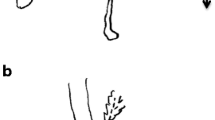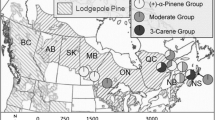Abstract
Diseased elms, treated with various doses of cacodylic acid in northwest England, became attractive to elm bark beetles (Coleoptera: Scolytidae). This attraction seemed to be independent of pheromone baits. However attractive the trees became, they were unsuitable to the beetles as breeding sites since significantly more beetles visited the trees than were stimulated to penetrate and attempt to breed. It seems as if colonization of trap trees by the bark saprophytePhomopsis oblonga following cacodylic acid treatment made the trees unsuitable to beetles for breeding.
Similar content being viewed by others
References
Blight, M.M., Mellon, F.A., Wadhams, L.J., andWenham, M.J. 1977. Volatiles associated withScolytus scolytus beetles on English Elm.Experienlia 33:845–847.
Blight, M.M.,King, C.J.,Wadhams, L.J., andWenham, M.J. 1980. Studies on chemically mediated behaviour in the large elm bark beetle,Scolytus scolytus (F). (Coleoptera: Scolytidae). Field Trials 1979.Forestry Commission R&D Paper 129. 34 pp.
Doskotch, R.W., Chatterji, S.K., andPeacock, J.W. 1970. Elm bark derived feeding stimulants for the smaller European elm bark beetle.Science 167:380–382.
Edwards, K. 1981. Studies on the effects of cacodylic acid, Ceratotect and Lignasan on the growth ofCeratocystis ulmi andPhomopsis oblonga in vitro. B.Sc. thesis.University of Salford.
Elkinton, J.S.,andWood, D.L. 1980. Feeding and boring behaviour ofIps Paraconfusus on the bark of host and nonhost tree species.Can. Entomol. 112:797–809.
Elkinton, J.S., Wood, D.L., andBrowne, L.E. 1981. Feeding and boring behavior of the bark beetle,Ipsparaconfusus, in extracts of ponderosa pine phloem.J. Chem. Ecol. 7:209–220.
Fairhurst, C.P., andKing, C.J. 1983. The effect of climatic factors on the dispersal of elm bark beetles, pp. 40–46, D. A. Burdekin (ed.).in Research on Dutch Elm Disease in Europe. Forestry Commission Bulletin. H.M.S.O., London, p. 60.
Gore, W.E., Pearce, G.T., Lanier, G.N., Simeone, J.B., Silverstein, R.M., Peacock, J.W., andCuthbert, R.A. 1977. Aggregation attractant of the European elm bark beetle,Scolytus Multistriatus. Production of individual components and related aggregation behavior.J. Chem. Ecol. 3:429–446.
Gibbs, J.N.,Burdekin, D.A., andBrasier, C.M. 1977. Dutch elm disease, Forestry Commission, Forest Record 115, H.M.S.O. 12 pp.
Gilbert, B.L., Baker, J.E., andMorris, D.M. 1967. Juglone (5-Hydroxy-1, 4-napthoquinone) fromCarya ovata, a deterrent to feeding byScolytus multistriatus.J. Insect Physiol. 13:1453–1459.
Jobling, J., andMitchell, A. 1974. Field recognition of British elms. Forestry Commission Booklet 42. H.M.S.O., London. 25 pp.
Lanier, G.N. 1981. Pheromone baited traps and trap trees in the integrated management of bark beetles in urban areas, pp. 115–131,in E.R. Mitchell (ed.). Management of Insects Pests with Semiochemicals. Plenum, New York.
Lanier, G.N. 1982. Dutch elm disease: A postscript.Arnoldia 42:78–87.
Norris, D.M. 1977. Role of repellents and detterents in feedingof Scolytus multistriatus, pp. 115–230,in P.A. Hedin (ed.). Host Plant Resistence to Pests. Am. Chem. Symp. Ser. No. 63.
O'callaghan, D.P. 1982. Low-level utilization of breeding material by elm bark beetles in northwest England. Forestry Commission Report on Forest Research 1982, H.M.S.O. London, pp. 58–60.
O'callaghan, D.P., andFairhurst, C.P. 1983. Evaluation of the trap-tree technique for control of Dutch elm disease in northwest England, pp. 23–28,in D.A. Burdekin (ed.). Research on Dutch Elm disease in Europe. Forestry Commission Bulletin, H.M.S.O., London, p. 60.
O'callaghan, D.P., Gallagher, E.M., andLanier, G.N. 1980. Field evaluation of phero mone-baited trap-trees to control elm bark beetles vectors of Dutch elm disease.Environ. Entomol. 8:181–185.
Peacock, J.W., Lincoln, A.C., Simeone, J.B., andSilverstein, R.M. 1971. Attraction ofScolytus multistriatus to virgin-female produced pheromone in the field.Ann. Entomol. Soc. Am. 64:1143–1149.
Pearce, G.T., Gore, W.E., Silverstein, R.M., Peacock, J.W., Cuthbest, R.A., Lanier, G.N., andSimeone, J.B. 1975. Chemical attractants for the smaller European elm bark beetle,Scolytus multistriatus (Coleoptera: Scolytidae)J. Chem. Ecol. 1:115–124.
Švihra, P., andKoehler, C.S.. 1981. Attraction of flyingScolytus multistriatus to cut wood of three elm species in California.Environ. Entomoi. 10:565–566.
Webber, J.F. 1981. A natural biological control for Dutch elm disease.Nature 292:449–451.
Wood, D.L. 1982. The role of pheromones, kairomones and allomones in the host selection behavior of bark beetles.Annu. Rev. Entomoi. 27:441–446.
Author information
Authors and Affiliations
Rights and permissions
About this article
Cite this article
O'Callaghan, D.P., Atkins, P.M. & Fairhurst, C.P. Behavioral responses of elm bark beetles to baited and unbaited elms killed by cacodylic acid. J Chem Ecol 10, 1623–1634 (1984). https://doi.org/10.1007/BF00988430
Received:
Revised:
Issue Date:
DOI: https://doi.org/10.1007/BF00988430




